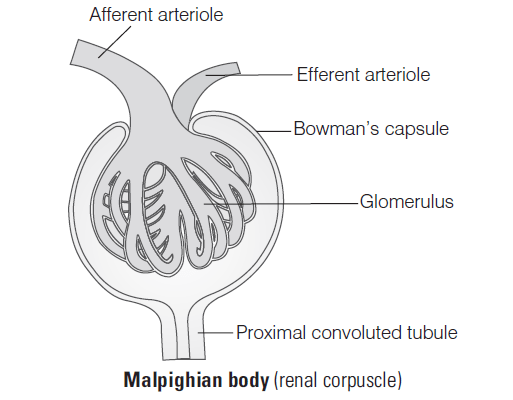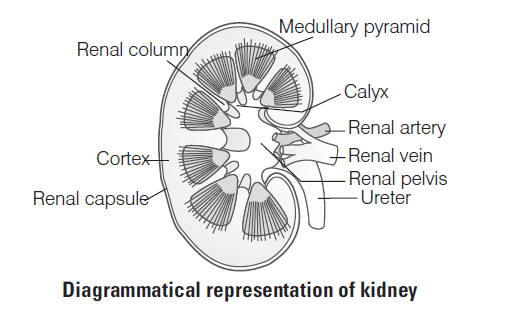NCERT Exemplar MCQs
Quiz Summary
0 of 15 Questions completed
Questions:
Information
You have already completed the quiz before. Hence you can not start it again.
Quiz is loading…
You must sign in or sign up to start the quiz.
You must first complete the following:
Results
Results
0 of 15 Questions answered correctly
Your time:
Time has elapsed
You have reached 0 of 0 point(s), (0)
Earned Point(s): 0 of 0, (0)
0 Essay(s) Pending (Possible Point(s): 0)
Categories
- Not categorized 0%
- 1
- 2
- 3
- 4
- 5
- 6
- 7
- 8
- 9
- 10
- 11
- 12
- 13
- 14
- 15
- Current
- Review
- Answered
- Correct
- Incorrect
-
Question 1 of 15
1. Question
The following substances are the excretory products in animals. Choose the least toxic form among them?
CorrectIncorrectHint
(b) Uric acid is the least toxictions. Insects, land tortoises, lizards, and birds change most of their nitrogenous waste into uric acid. It is the least toxic because it is insoluble in water as there are in solid form, thus, contains the least water. In birds, uric acid mixes with undigested food to form the bird dropping.
Urea moves to the blood and gets filtered and eliminated with water in urine via the kidneys.
Ammonia is very toxic and needs water for diffusion.
Carbon dioxide excretion takes place through the lungs. -
Question 2 of 15
2. Question
Filtration of the blood takes place at
CorrectIncorrectHint
(d) Filtration of blood takes place at Malpighian body. Malpighian body or corpuscle comprises of glomerulus and Bowman’s capsule. Filtration of blood takes place in glomerulus through glomerular filtration. In which blood enters the glomerules through an afferent arteriole and leaves it through efferent arteriole.

Proximal Convoluted Tubule (PCT), is lined by cuboidal epithelium cells bearing brush border and allows the reabsorption of salts by active transport.
Distal Convulated Tubule (DCT), allows conditional reabsorption of \(\mathrm{Na}^{+}\)and water and selective secretion of \(\mathrm{H}, \mathrm{K}^{+}, \mathrm{NH}_{3}\) to maintain \(\mathrm{pH}\) and \(\mathrm{Na}-\mathrm{K}\) balance in blood.
Collecting Duct extends from cortex of kidney to the inner part of medulla. Large amount of water is reabsorbed from this region to produce the concentrated urine. -
Question 3 of 15
3. Question
Which of the following statements is correct?
CorrectIncorrectHint
(b) Aldosterone facilitates water reabsorption
-
Question 4 of 15
4. Question
Which of the following is removed from our body by the lungs?
CorrectIncorrectHint
(a) The average person breathes out around 500 liters of \(C O_{2}\), which amounts to around \(1 \mathrm{~kg}\) in mass.In an average person, less than one litre of water is excreted by the skin as sweat, large intestine as faeces (ammonia), and kidney as urine. Thus, \(C O_{2}\) in a large quantity is removed from our body by the lungs.
-
Question 5 of 15
5. Question
The pH of human urine is approximately
CorrectIncorrectHint
(c) Urine is a transparent, light yellow liquid with a slightly acidic \(\mathrm{pH}\) (avg. \(\mathrm{pH} 6.0\) ). However, the \(\mathrm{pH}\) range of urine is normally between \(4.5\) \(8.2\) depending upon the amount of acidic and basic food in diet.
-
Question 6 of 15
6. Question
Different types of excretory structures and animals are given below. Match them appropriately and mark the correct answer from among those given below:
\(
\begin{array}{|c|c|}
\hline \text { Excretory sturucture organ } & \text { Animals. } \\
\hline \text { A. Protonephridia } & \text { (i) Prawn } \\
\hline \text { B. Nephridia } & \text { (ii) Cockroach } \\
\hline \text { C. Malpighian tubules } & \text { (iii) Earthwworm } \\
\hline \text { D. Green gland or Antennal gland } & \text { (iv) Flatworms } \\
\hline
\end{array}
\)CorrectIncorrectHint
(a)
1. Prawn possesses green glands or antennal glands as their excretory structures.
2. Cockroach possesses Malpighian tubules as their excretory structures.
3. Earthworm possesses nephridia as their excretory structures.
4. Flatworm possesses protonephridia as their excretory structures. -
Question 7 of 15
7. Question
Which one of the following statements is incorrect?
CorrectIncorrectHint
(d) Animals that excrete uric acid are called uricotelic. Uricotelic animals include most insects, some land crustaceans, land snails, land reptiles, and birds
-
Question 8 of 15
8. Question
Which of the following pairs is wrong?
CorrectIncorrectHint
(b) Animals that eliminate uric acid in the style of waste are called uricotelic organisms. birds, snakes, and lizards are a number of examples of uricotelic organisms.
Animals that eliminate organic compounds (urea) in the form of waste are termed ureotelic animals. fishes, amphibians, and mammals are a few examples of ureotelic animals.
Animals whose main nitrogenous excretory waste is ammonia are termed ammonotelic. cnidarians, poriferans, echinoderms, fishes, and tadpoles are some of the examples. Hence, Ureotelic-insects is a wrongly matched pair. -
Question 9 of 15
9. Question
Which one of the following statements is incorrect?
CorrectIncorrectHint
(b) Inside the kidney the cortical region extends in between the medullary pyramids as renal columns are called column of Bertini, not as renal pelvis.

-
Question 10 of 15
10. Question
The condition of accumulation of urea in the blood is termed as
CorrectIncorrectHint
(c) In uremia, the concentration of urea goes high in blood because the tubules are not able to remove it from the blood. Uremia is the accumulation of urea in the blood. It occurs due to malfunctioning of the kidney.
Renal calculi refer to the formation of stones or insoluble mass of crystallised salts (oxalates, etc) within the kidney.
Glomerulonephritis is the inflammation of the glomeruli of the kidney.
Ketonuria is a medical condition in which ketone bodies are present in the urine. It is seen during starvation or more commonly in type 1 diabetes mellitus. -
Question 11 of 15
11. Question
Which one of the following is also known as antidiuretic hormone?
CorrectIncorrectHint
(b) Antidiuretic hormone (ADH) is also known as Vasopressin or Pitressin. It is secreted from the posterior lobe of the pituitary gland.
-
Question 12 of 15
12. Question
Match the terms given in Column I with their physiological processes given in Column II and choose the correct answer
\(
\begin{array}{|l|l|l|l|}
\hline & \text { Column I } & & \text { Column II } \\
\hline \text { A. } & \text { Proximal convoluted tubule } & \text { i. } & \text { Formation of concentrated urine } \\
\hline \text { B. } & \text { Distal convoluted tubule } & \text { ii. } & \text { Filtration of blood } \\
\hline \text { C. } & \text { Henle’s loop } & \text { iii. } & \text { Reabsorption of } 70-80 \% \text { of electrolytes } \\
\hline \text { D. } & \text { Counter-current mechanism } & \text { iv. } & \text { Ionic balance } \\
\hline \text { E. } & \text { Renal corpuscle in medulla } & \text { v. } & \text { Maintenance of concentration gradient } \\
\hline
\end{array}
\)
Options:CorrectIncorrectHint
(b)
(A) Proximal convoluted tubule – Reabsorption of \(70-80 \%\) of electrolytes
(B) Distal convoluted tubule – Ionic balance
(C) Henle’s loop – Formation of concentrated urine
(D) Counter current mechanism – Maintenance of concentration gradient in medulla
(E) Renal capsule – Filtration of blood -
Question 13 of 15
13. Question
Match the abnormal conditions given in Column A with their explanations given in Column B and Choose the correct option
\(
\begin{array}{|l|l|l|l|}
\hline & \text { Column A } & & \text { Column B } \\
\hline \text { A. } & \text { Glycosuria } & \text { i. } & \text { Accumulation of uric acid in joints } \\
\hline \text { B. } & \text { Renal calculi } & \text { ii. } & \text { Inflammation in glomeruli } \\
\hline \text { C. } & \text { Glomerulo-nephritis } & \text { iii. } & \text { Mass of crystallised salts within the kidney } \\
\hline \text { D. } & \text { Gout } & \text { iv. } & \text { Presence of glucose in urine } \\
\hline
\end{array}
\)
Options:CorrectIncorrectHint
(c) Glycosurea/glucosuria is the presence of glucose in the urine.
Renal calculi is the formation of mass of crystallised salts within the kidney.Glomerular nephritis is the inflammation of the glomeruli of the kidney.
Gout is the accumulation of uric acid crystals in joints causing inflammation.
-
Question 14 of 15
14. Question
We can produce a concentrated/ dilute urine. This is facilitated by a special mechanism. Identify the mechanism.
CorrectIncorrectHint
(d) The counter current mechanism helps to concentrate the filtrate which occurs in loop of Henle and vasa recta in the medulla region of the kidney. This gradient is mainly caused by \(\mathrm{NaCI}\) and urea. It helps in easy absorption of water from the filtrate present in the collecting duct so that the concentration of the filtrate (urine) is increased. Therefore, hypertonic urine is produced in human beings.
-
Question 15 of 15
15. Question
Dialysing unit (artificial kidney) contains a fluid which is almost same as plasma except that it has
CorrectIncorrectHint
(c) Artificial kidney (Dialysing unit ) is a machine that is used for filtration of blood in people whose kidneys are failed or damaged by the process called Dialysis.
Dialysis fluid is produced by the blending of treated water with electrolytes at the patient’s bedside. The composition of the dialysis fluid should match that of plasma except for the nitrogenous waste (urea). So the answer is ‘No urea’.